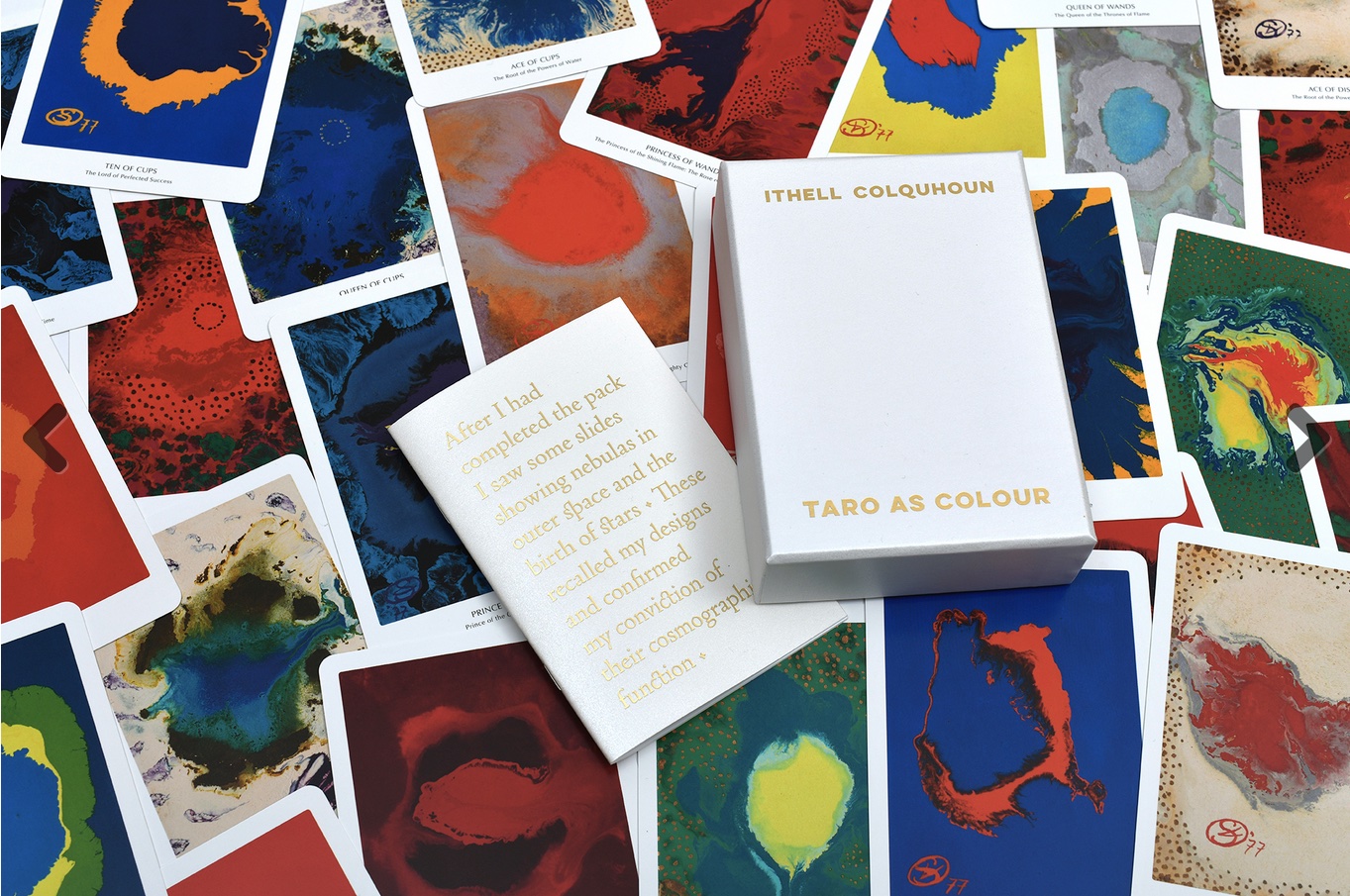Ithell Colquhoun's Taro deck, Ithell Colquhoun Taro as Colour (2022), consists of seventy-eight abstractions originally created with enamel and first exhibited in 1977. The oversized deck (4 3/8 x 6 1/8") is printed on high quality card stock with a semi-gloss finish and comes in a sturdy but elegant white box with gold lettering. The cards have white borders and mottled pale brown backs suggesting tea staining. The little white book includes an introduction to the deck by Richard Shillitoe and a copy of Colquhoun's short essay "Taro as Colour." Shillitoe is well known for his book Ithell Colquhoun: Magician Born of Nature (2009) and, having actually met Colquhoun, he offers a unique perspective on the artist.
Colquhoun was a life-long student of the occult and of Tarot. She worked with numerous traditions, most notably that of the Golden Dawn. As both Hale and Shillitoe note, the inspiration to create her own Tarot deck probably came from her involvement with Tamara Bourkoun's (1911–1990) Golden Dawn-based Order of the Pyramid and Sphinx. According to a back note in the little white book, the publisher has "supplemented Colquhoun's preference for Golden Dawn titles with the traditional names associated with the taro" (22). This note simply means that "names," such as Wheel of Fortune; and King, Queen, Prince, and Princess of whatever suit appear above the "titles" found in MacGregor Mathers's Book T. For example, the name King of Pentacles found in connection with the familiar Rider-Waite-Smith Tarot (1909) card is presented as given by Mathers with its associated title: "King of Disks The Lord of the Wide and Fertile Land: The King of the Spirits of the Earth." Incidentally, according to Shillitoe, Colquhoun made considerable use of Arthur E. Waite and Pamela Colman Smith's Rider-Waite-Smith Tarot while also relying on other text-based sources.
The colour scales Colquhoun used are also based on those of the Golden Dawn, but she seems to have mixed and matched them according to her intuition or meditation-derived ideas. For example, she gives the colours for the Ace of Swords as "White, flecked gold | pale yellow." In the colour scales recorded in Israel Regardie's The Golden Dawn, 6th edition (Llewellyn), the color for the Ace of Swords is "White Brilliance," while that for the Ace of Pentacles is "White flecked gold." Colquhoun's colours for the 6 of Swords are "Pale yellow | rose pink." The Golden Dawn color for that card is "Rich Salmon," but the color for the 6 of Wands is "Clear pink rose," that for the 6 of Cups is "Yellow (Gold)," and that for the 6 of Pentacles is "Gold amber." Given the seriousness with which Colquhoun undertook her card meditations and art, it would be a mistake to dismiss her alterations as whimsy. The same may be said for her particular alignments of the elements with the Tarot trumps, court cards, and pips. As a student of numerous occult systems, she would have understood perfectly well that these systems are ultimately the work of people; even those believed to have been transcribed from not-quite-human sources could only be transcriptions and therefore subject to both error and correction.
Colquhoun's Taro—she preferred to call it Taro not Tarot—was also influenced by her training as an artist and awareness of contemporary mainstream art: she combined the approach of a color field painter with that of a dedicated occult ritualist deeply committed to meditation on both the cards and color. However, it would be interesting to know if Colquhoun knew of Mary Gartside's 1804–1808 publications on colour theory which go beyond the conventional prismatic charts and tables to include very painterly watercolor "blots," as they are called. Gartside's work was little referenced at the time, but did attract attention at mid-century. Colquhoun's Taro paintings are quite similar to these blots with the difference arising in significant part from the use of enamel as a medium and the systematic applications of color relative to a scale intended to serve purposes other than the illustration of science-based color relationships. The visual kinship may be one of convergence, rather than influence, however, given the more recent movements of Abstract Expressionism and Colour Field Painting, and the numerous artists associated with Pop Art who experimented with visual effects. While some of these artists presumed to capture the sublime or sought to explore color and shape as if they were scientists, it is unlikely that many, if any, were as devoted to finding meaning in color as was Colquhoun.
For collectors and students of the Golden Dawn, Ithell Colquhoun's deck and the earlier associated book belong right beside The Tarot of Leonora Carrington (Fulgur Press 2020) and Major Arcana: Leonora Carrington [22 cards] (Fulgur Press, 2020). The Tarot-associated work of both Carrington and Colquhoun has been entirely missed or completely under-estimated for decades and these publications make it possible to not only read about their accomplishments, but to understand their realization through the use of commercial editions of the decks they created.
~review by Emily E. Auger
Artist: Ithell Colquhoun
23-page LWB by Ithell Colquhoun and Richard Shillitoe
Fulgur Press, 2022
About $72.00 from the publisher
Related publications from Fulgur Press include Ithell Colquhoun's (1906–1988) Decad of Intelligence (2017) and the book Taro as Colour (2018) [reviewed at Mythlore 40.1] with an introduction by Amy Hale, full colour illustrations of Colquhoun's complete Taro deck, and an index of colour thumbnails of the cards accompanied by their titles and the colors associated with each. Hale is also the author of a biography of Ithell Colquhoun, The Supersensual Life of Ithell Colquhoun Artist and Occultist (Strange Attractor Press 2020) [reviewed at Facing North], and editor of Essays on Women in Esotericism: Beyond Seeresses and Sea Priestesses (Palgrave 2021).
Ithell Colquhoun Taro as Colour

©
2010 - 2024
Facing North
